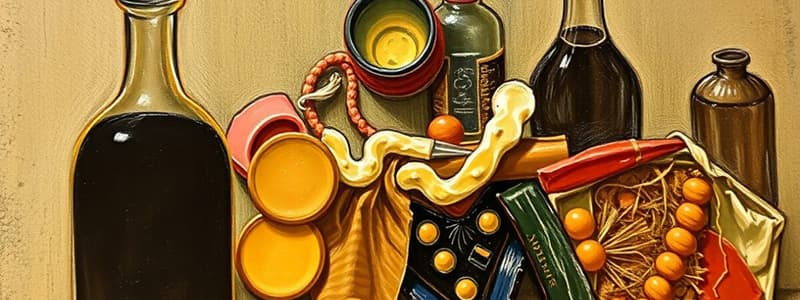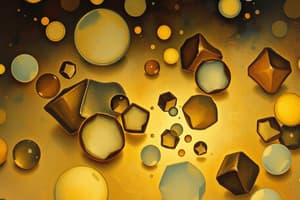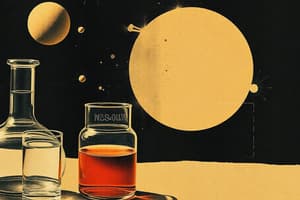Podcast
Questions and Answers
What is the chemical symbol for magnesium?
What is the chemical symbol for magnesium?
- M
- Mg (correct)
- Mn
- MgO
What happens to magnesium when it is heated?
What happens to magnesium when it is heated?
- It dissolves in the air.
- It turns into a gas.
- It burns with a bright light. (correct)
- It melts into a liquid.
What substance is formed when magnesium burns in oxygen?
What substance is formed when magnesium burns in oxygen?
- Magnesium oxide (correct)
- Magnesium hydroxide
- Magnesium sulfate
- Magnesium chloride
Which of the following statements is true about elements?
Which of the following statements is true about elements?
What distinguishes a compound from an element?
What distinguishes a compound from an element?
What is formed when magnesium atoms bond with oxygen atoms?
What is formed when magnesium atoms bond with oxygen atoms?
What is the composition of one molecule of magnesium oxide?
What is the composition of one molecule of magnesium oxide?
What type of change occurs when magnesium is burned?
What type of change occurs when magnesium is burned?
What are the characteristics of a solution?
What are the characteristics of a solution?
Which of the following is an example of a colloid?
Which of the following is an example of a colloid?
What effect do colloidal particles exhibit when light passes through them?
What effect do colloidal particles exhibit when light passes through them?
How do suspensions differ from solutions?
How do suspensions differ from solutions?
Why can compounds not be separated by physical methods?
Why can compounds not be separated by physical methods?
Which of the following best describes a suspension?
Which of the following best describes a suspension?
Which of these is NOT a characteristic of colloids?
Which of these is NOT a characteristic of colloids?
What distinguishes a mixture from a compound?
What distinguishes a mixture from a compound?
What defines a pure substance?
What defines a pure substance?
Which of the following correctly describes an element?
Which of the following correctly describes an element?
What is the difference between a compound and a mixture?
What is the difference between a compound and a mixture?
Which of the following is an example of a homogeneous mixture?
Which of the following is an example of a homogeneous mixture?
A suspension is best described as which of the following?
A suspension is best described as which of the following?
What is a characteristic of a heterogeneous mixture?
What is a characteristic of a heterogeneous mixture?
What role does a solute play in a solution?
What role does a solute play in a solution?
Which of the following substances is considered a compound?
Which of the following substances is considered a compound?
Flashcards are hidden until you start studying
Study Notes
Colloids
- Colloids are mixtures with particles larger than solutions but smaller than suspensions.
- Examples: milk, mayonnaise, jelly, fog
- Colloids appear homogeneous to the naked eye, but are heterogeneous at a microscopic level.
- Particles do not settle over time.
- Exhibit the Tyndall effect (scattering of light).
- Cannot be separated by ordinary filtration.
Solutions
- Solutions are homogeneous mixtures.
- Solute particles are evenly distributed and do not settle over time.
- Cannot be separated by filtration.
- Examples: saltwater, vinegar, air.
- Solutions are transparent; light passes through without scattering.
Suspensions
- Suspensions are heterogeneous mixtures.
- Particles are large enough to settle out over time.
- Can be separated by filtration.
- Examples: muddy water, sand in water, flour in water.
- Suspensions are opaque or cloudy, and particles scatter light.
Elements
- Elements are pure substances consisting of only one type of atom.
- Cannot be broken down into simpler substances by chemical means.
- Examples: magnesium (Mg), oxygen (O).
Compounds
- Compounds are formed when two or more different elements are chemically combined.
- Have properties distinct from the elements that compose them.
- Cannot be separated by physical methods like mixtures.
- Examples: water (H2O), magnesium oxide (MgO).
Mixtures
- Mixtures are combinations of two or more substances that are physically combined.
- Can be separated by physical means.
- Two main types: homogeneous and heterogeneous.
Homogeneous Mixtures
- Composition is uniform throughout.
- Different particles are not visible.
- Examples: saltwater, sugar dissolved in tea.
Heterogeneous Mixtures
- Composition is non-uniform.
- Different particles are visible.
- Examples: salt and pepper, sand and water.
Burning Magnesium
- A piece of magnesium ribbon is a pure element, consisting only of magnesium atoms (Mg).
- When heated in a flame, magnesium reacts with oxygen from the air.
- This chemical reaction results in the formation of magnesium oxide (MgO), a compound.
- Magnesium oxide is a white powder that is different from the original magnesium ribbon.
- This demonstrates how elements can combine to form new substances with different properties.
Studying That Suits You
Use AI to generate personalized quizzes and flashcards to suit your learning preferences.




